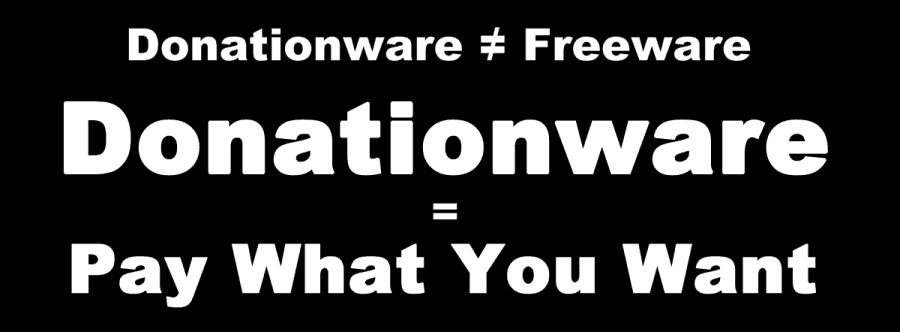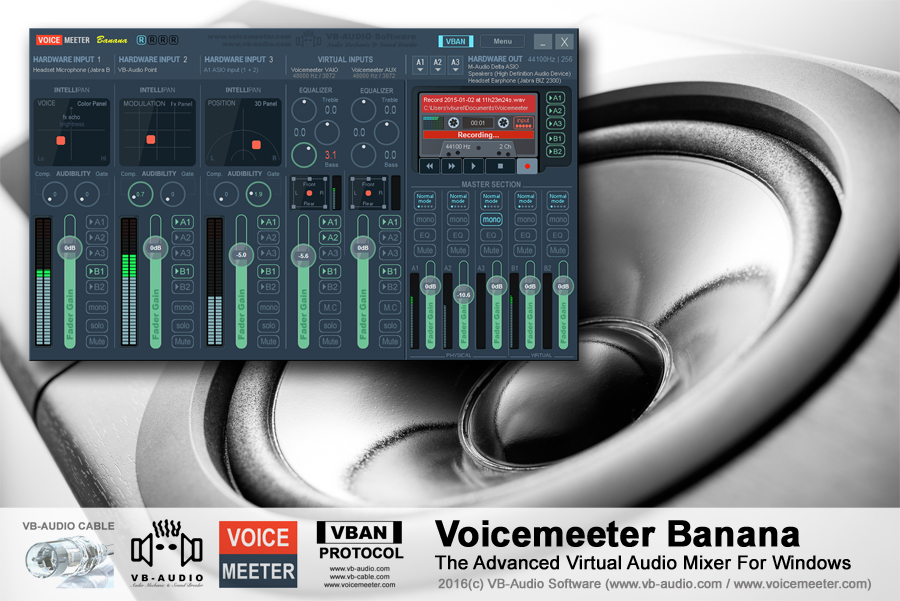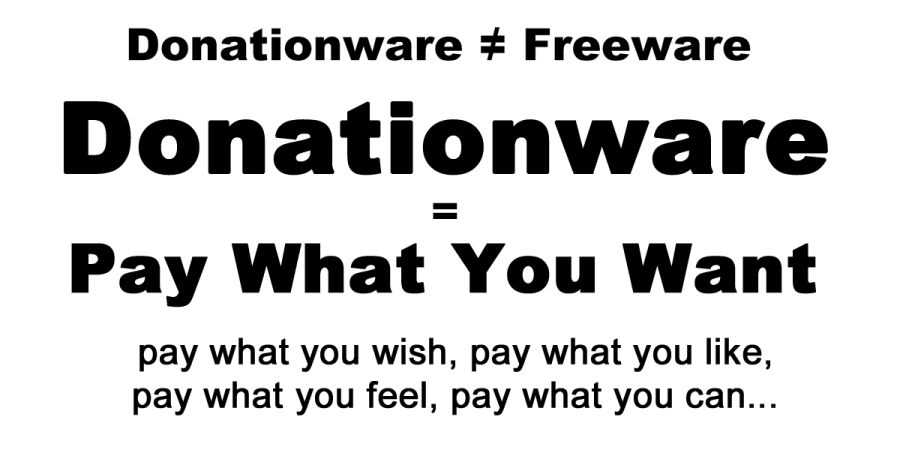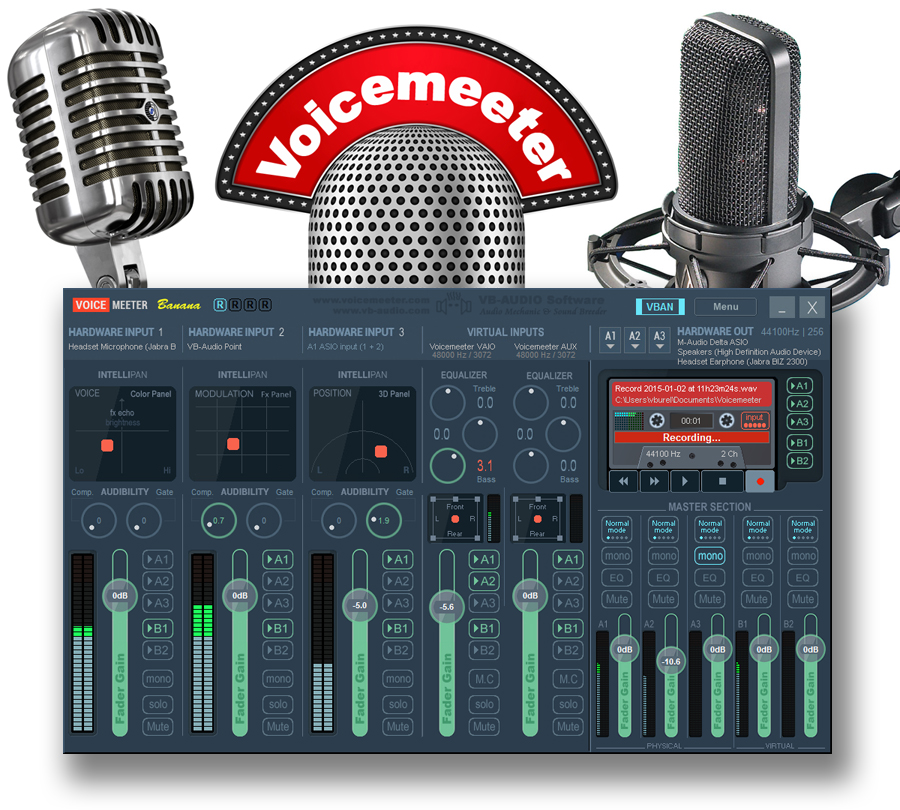

|
|
|
|
|
|
|
|

|
|
"Donationware" - an alternative economic system. The "Donationware" model proves to be a successful system for certain types of software products, especially those which are for mass market (or supposed to interest a large number of users). It's the model that we chose for Voicemeeter (and other VB-CABLE products) because we were originally following a research and development approach and we weren't sure that our solutions would be technically satisfactory. VB-CABLE and Voicemeeter provide new features in terms of sound control, but the constraints vary strongly from one user to another, from one use to another and from one configuration to another. |

|
|
Our expectation was to allow a maximum amount of users to benefit from our software in order to validate our technology over a wide range of different situations. With this in mind, the "Donationware" or "Pay what you want" system, (where the user, himself, chooses the price of the license that he pays, also called PWYW), allows a free access and encourages users to give us their feedback, comments and constructive queries in a way that allows them, in a positive and caring spirit, to participate in the final version of the product. During this validation period of 1 to 2 years, we have also been able to see the functioning of this system on a purely economical level. The Donationware system has, in fact, a number of advantages when you wish to sell your software worldwide. Making a fixed price is problematic on a worldwide scale because the buying power and currencies vary from one user to another. The Donationware system allows the user to adapt the price according to his own economical situation. The price evaluation is also linked to the usage gained. For example, using Voicemeeter to connect two sets of headphones is equivalent to a simple double headphone adaptor. However, if you use it to replace your mixing deck, tape player or your equalizer, the usage gained is rather different. The price would also depend on the usage that you are making out of Voicemeeter. For instance, a simple mono button could really help someone who, deaf in one ear, has been waiting for this function whilst using Windows for the last 20 years. This mono button will enable him to hear the left and right sounds through the same speaker. This auto evaluation pricing system is well adapted to software which isn't used in the same way by all users. Finally, the idea behind the Donationware system, other than the wish to allow the software accessible to all, is also to create a new economical system that gives the responsibility to the user. Therefore, he can choose to fix his own estimated license price according to his means, to the service gained, and to his wish to support our Research and Development team. He can do this as many times as he wishes. Some users even make a fixed monthly donation, as though it was a SAAS license. Obviously, for a free donation system, many users will confuse Donationware and Freeware. If we also consider those who have made a non-conclusive trial with the product or those who don't really use it, we can conclude that the ratio of donations to downloads is rather weak (less than 1%), but more profitable than an advert income through the "pay per click" system. The final income is relatively proportional to the number of downloads. However, a certain audience needs to be reached to earn a significant income. If the Donationware system doesn't suit a major company (though it would still depend on the audience), it could suit small companies or independent developers, especially when the software is successful, in allowing the company or the brand to be more visible. Marketing is expensive and selling a software product has become difficult without a major internet infrastructure. The Donationware system is an alternative to the "free to play" system (free software which becomes paying to access other functions or to unlock other levels...) but at a "Pay What You Want" price without obligations. For a more professional usage and/or a diffusion within a professional context or any other context that isn't compatible with the "Donationware" system spirit (for example because the product is simply not visible by the user...), we make price offers for volume licencing. Get more info about Volume Licensing... Retrieve this article on our Facebook or download as PDF Document. Contact: www.vb-audio.com / www.voicemeeter.com / www.vb-cable.com |

|
|
[FR] Donationware, un modèle économique alternatif. Le modèle du Donationware s'avère être un modèle payant pour certains types de produits logiciels, notamment les produits grand publics (ou censés intéresser un grand nombre d'utilisateurs). C'est le modèle que nous avons choisi pour Voicemeeter (et autre produits de la gamme VB-CABLE) parce que nous étions au départ, dans une démarche de R&D et nous n'étions pas certains que nos solutions seraient techniquement satisfaisantes. VB-CABLE et Voicemeeter permettent de nouvelles choses en termes de gestion du son, mais les contraintes varient fortement d'un utilisateur à l'autre, d'un usage à l'autre, d'une configuration à l'autre. Nous voulions donc faire profiter nos logiciels à un maximum d'utilisateurs pour valider nos technologies sur un grand nombre de configurations différentes. Dans cette optique, le modèle du "donationware" ou "prix libre", où l'utilisateur paye le prix de licence qu'il veut, permet un accès libre et encourage à rapporter les problèmes, à faire des commentaires/requêtes constructifs et de manière générale à participer à la finalisation du produit dans un esprit positif et bienveillant. Le fait est que durant cette période de validation de un à deux ans, nous avons pu voir ce modèle fonctionner aussi sur le plan purement économique. En effet le modèle du Donationware a plusieurs avantages et prend son sens quand l'on souhaite vendre son logiciel dans le monde entier. Faire un prix unique pose des problèmes à l'international car le pouvoir d'achat des utilisateurs varient d'un pays à l'autre, d'une monnaie à l'autre. Le modèle du Donationware permet donc une auto adaptation du prix de la licence en fonction du pays et de sa monnaie. L'évaluation de ce prix s'apprécie aussi au regard du service rendu. Utiliser Voicemeeter pour connecter deux casques audio, s'assimile à la fonction d'un simple adaptateur double casque. Le service rendu est dans ce cas moindre que pour un autre utilisateur qui remplacerait par Voicemeeter, sa console de mixage, son magnétophone ou son équaliseur. Cependant cette notion dépend aussi des besoins de l'utilisateur. Un simple bouton Mono peut rendre un immense service pour quelqu'un de sourd d'une oreille qui attend cette fonction depuis 20 ans sous Windows, pour enfin entendre les sons gauche et droit sur un seul haut parleur. L'utilisateur paie d'abord pour le service rendu et c'est aussi un concept très adapté aux logiciels qui peuvent être utilisés de manières très différentes. Enfin l'Idée derrière le modèle du donationware, outre la volonté de rendre le logiciel accessible à tous, est aussi de créer un nouveau modèle économique qui responsabilise l'utilisateur. Ainsi peut il choisir de payer la licence du logiciel sur différents modes : en fonction de ses moyens, en fonction du service rendu, en soutien à nos équipe de développement, et ceux autant de fois qu'ils le souhaitent. Certains font même des donations mensuelles, comme s'il s'agissait d'une licence SAAS. Evidemment, pour une donation non contrainte, beaucoup d'utilisateurs vont confondre donationware et freeware. Si l'on considère aussi ceux qui ont fait des essais non-concluants ou qui n'utilisent pas vraiment le produit, on constate au final un ratio donations/téléchargements assez faible (moins de 1%), mais plus rentable qu'un revenu publicitaire en "Pay per click". Les revenus sont au final assez proportionnels au nombre de téléchargements, Il faut cependant atteindre une certaine audience pour espérer gagner un revenu significatif. Si le modèle du Donationware ne pourrait pas convenir à une entreprise d'envergure (quoique cela reste une question d'audience), il peut convenir à de petites structures ou des développeurs indépendants, notamment quand le logiciel rencontre un certain succès car il permet aussi de rendre l'entreprise ou la marque visible. Faire du marketing coute cher, et vendre un produit logiciel est devenu difficile sans une infrastructure internet importante. Le modèle du donationware apparait alors comme une alternative au modèle du "free to play" (les logiciels gratuits qui proposent de payer pour avoir d'autres fonctionnalités, débloquer d'autres niveaux..) mais en "prix libre", et sans obligation. Pour un usage plus professionnel et/ou une diffusion dans un cadre d'entreprises ou tout autre cadre qui n'est pas compatible avec l'esprit du "Donationware" (ou parce que le produit n'est tout simplement pas visible pour l'utilisateur), nous faisons des propositions de prix pour des licences en volume... Retrouvez cet article sur notre Facebook ou télécharger le PDF Document. Contact: www.vb-audio.com / www.voicemeeter.com / www.vb-cable.com |

|
|